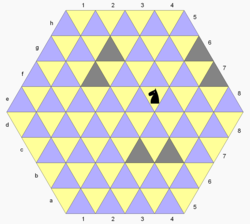Triangular chess (game)

Triangular chess is a chess variant for two players invented by George R. Dekle Sr. in 1986.[1][2] The game is played on a hexagon-shaped gameboard comprising 96 triangular cells. Each player commands a full set of chess pieces in addition to three extra pawns and a unicorn.
Triangular chess and its variation tri-chess were included in World Game Review No. 10 edited by Michael Keller.[3]
Game rules
[edit]The starting setup is as shown. As in chess, White moves first, and the object is checkmate. Other standard conventions apply as well, including castling, the pawn's initial two-step move, the en passant capture, and promotion at the last rank. The triangular geometry, however, implies special move patterns for the pieces.
Piece moves
[edit]- A rook moves in a straight line starting through a cell edge. (Three directions are possible.)
- A bishop moves in a straight line starting through a cell vertex. (Three directions.)
- The queen moves as a rook or bishop. (Six directions.)
- The king moves one step as a queen. When castling, the king slides two cells if castling short (0-0); three cells if castling long (0-0-0).
- A knight moves in the pattern: two steps as a bishop, then one step as a rook in an orthogonal direction. A knight leaps any intervening men.
- The unicorn moves in the pattern: two steps as a rook, then one step as a rook in an orthogonal direction. Like a knight, the unicorn leaps any intervening men.
- A pawn moves straight forward one step at a time, whether crossing a cell edge or vertex. On its first move it may optionally move two steps straight forward. A pawn captures to either cell adjoining the cell immediately in front, in the same rank.
- If a pawn reaches a board edge where no step straight forward exists, the pawn continues to advance toward promotion using its capture move (whether there are men to capture or not).
-
Rook moves
-
Bishop moves
-
Queen moves
-
King moves
-
Knight moves
-
Unicorn moves
-
The rook moves along cells in the diagram colored light gray; the bishop along cells colored dark gray; the black knight can move to green dots, or capture the rook; the white unicorn can move to yellow dots, or capture the bishop.
-
The white pawns can move to cells marked with green dots, or capture on red dots. The white pawn on f21[a] has no step straight forward, so advances one step at a time to promotion using its capture move, either moving or capturing. If the black pawn on g46 advances, the white pawn on e54 can capture it, for example: 1... e55 2. exf64 e.p.
Tri-chess
[edit]Tri-chess is a variation of triangular chess created by Dekle in the same year.[4][2] The game is for two players and is the same as triangular chess in all respects except the moves of the bishop, rook, queen, and king are increased.
- A bishop moves in six directions constituting board diagonals.
- A rook moves in six directions along horizontal ranks or oblique files.
- The queen moves as a rook or bishop. (Twelve directions.)
- The king moves one step as a bishop or two steps as a rook.
See also
[edit]- Also by George Dekle:
- Masonic chess
- Tri-chess – a three-player variant with triangular cells
- Trishogi – a shogi variant with triangular cells
Notes
[edit]- ^ The notation system used identifies each cell by its horizontal rank (letter) and the intersection of two oblique files (two numbers).
References
[edit]- ^ Pritchard (1994), pp. 321–22
- ^ a b Pritchard (2007), p. 213
- ^ Keller (1991)
- ^ Pritchard (1994), p. 323
Bibliography
- Keller, Michael, ed. (June 1991). "A Panorama of Chess Variants". World Game Review. No. 10. Michael Keller. ISSN 1041-0546.
- Pritchard, D. B. (1994). The Encyclopedia of Chess Variants. Games & Puzzles Publications. ISBN 0-9524142-0-1.
- Pritchard, D. B. (2007). Beasley, John (ed.). The Classified Encyclopedia of Chess Variants. John Beasley. ISBN 978-0-9555168-0-1.
External links
[edit]- Triangular Chess Tri-Chess simple programs by Ed Friedlander (Java)
- Triangular Chess See detailed rule descriptions, piece movements and play this variant on Omnichess








![The white pawns can move to cells marked with green dots, or capture on red dots. The white pawn on f21[a] has no step straight forward, so advances one step at a time to promotion using its capture move, either moving or capturing. If the black pawn on g46 advances, the white pawn on e54 can capture it, for example: 1... e55 2. exf64 e.p.](http://upload.wikimedia.org/wikipedia/commons/thumb/3/32/Triangular_Chess%2C_pawn_moves.PNG/250px-Triangular_Chess%2C_pawn_moves.PNG)


